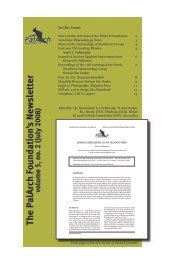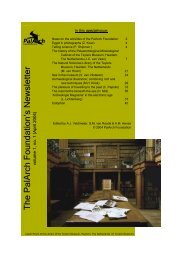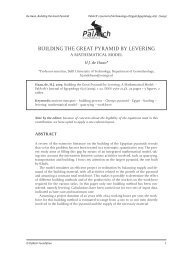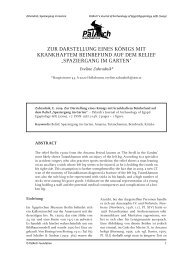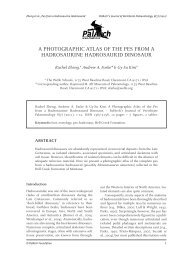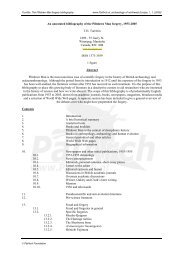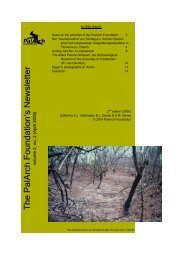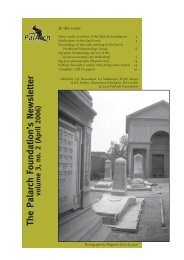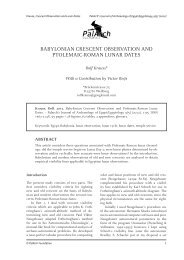neural spine bifurcation in sauropod dinosaurs of the - PalArch
neural spine bifurcation in sauropod dinosaurs of the - PalArch
neural spine bifurcation in sauropod dinosaurs of the - PalArch
You also want an ePaper? Increase the reach of your titles
YUMPU automatically turns print PDFs into web optimized ePapers that Google loves.
Wedel & Taylor, Neural Sp<strong>in</strong>e Bifurcation <strong>in</strong> Sauropods <strong>PalArch</strong>’s Journal <strong>of</strong> Vertebrate Palaeontology, 10(1) (2013)<br />
apophysis and <strong>the</strong> right rib is also broken. BYU<br />
12613 might represent a small adult Diplodocus<br />
or Kaatedocus (Tschopp & Mateus, 2012) or a<br />
subadult <strong>in</strong> which <strong>the</strong> <strong>neural</strong> arch and cervical<br />
ribs fused relatively early <strong>in</strong> ontogeny; current<br />
evidence is <strong>in</strong>sufficient to falsify ei<strong>the</strong>r hypo<strong>the</strong>sis.<br />
Never<strong>the</strong>less, it <strong>in</strong>dicates that small <strong>in</strong>dividuals<br />
<strong>of</strong> known taxa can have fully fused vertebrae<br />
and deeply bifurcated <strong>neural</strong> <strong>sp<strong>in</strong>e</strong>s.<br />
Size can be a particularly mislead<strong>in</strong>g <strong>in</strong>dicator<br />
<strong>of</strong> ontogenetic age for isolated vertebrae,<br />
because vertebrae change so dramatically <strong>in</strong><br />
size along <strong>the</strong> vertebral column <strong>in</strong> <strong>sauropod</strong>s.<br />
In <strong>the</strong> famous mounted skeleton <strong>of</strong> Diplodocus<br />
carnegii CM 84/94, <strong>the</strong> largest post-axial cervical<br />
vertebra, C15, has a posterior centrum diameter<br />
more than three and a half times that <strong>of</strong> C3,<br />
<strong>the</strong> smallest (245 vs 69 mm; Hatcher, 1901: 38;<br />
figure 8).<br />
Although open neurocentral jo<strong>in</strong>ts (properly<br />
synchondroses while develop<strong>in</strong>g and synostoses<br />
when fused) <strong>in</strong>dicate juvenile or subadult<br />
status <strong>in</strong> extant crocodilians (Brochu, 1996;<br />
Ikejiri, 2012) and <strong>in</strong> fossil archosaurs (Irmis,<br />
2007), <strong>in</strong>clud<strong>in</strong>g <strong>sauropod</strong>s (e.g. Peterson &<br />
Gilmore, 1902; Myers & Fiorillo, 2009; Remes et<br />
al., 2009), it is not clear that <strong>the</strong> reverse is true.<br />
In o<strong>the</strong>r words, fused neurocentral synostoses<br />
do not necessarily <strong>in</strong>dicate <strong>the</strong> atta<strong>in</strong>ment <strong>of</strong><br />
ei<strong>the</strong>r full size or skeletal maturity. Regard<strong>in</strong>g<br />
full size, <strong>the</strong> MB.R.2180 (formerly HM SI) lectotype<br />
specimen <strong>of</strong> Giraffatitan brancai is only<br />
about 75% <strong>the</strong> size <strong>of</strong> <strong>the</strong> mounted paralectotype<br />
MB.R.2181 (formerly HM SII) and only<br />
Figure 8. Third and fifteenth cervical vertebrae <strong>of</strong><br />
Diplodocus carnegii CM 84/94 <strong>in</strong> posterior view. The<br />
cotyle diameters <strong>of</strong> <strong>the</strong> vertebrae are 69 and 245 mm,<br />
respectively. Modified from Hatcher (1901: plate 6).<br />
66% <strong>the</strong> size <strong>of</strong> <strong>the</strong> largest known <strong>in</strong>dividuals<br />
<strong>of</strong> Giraffatitan from Tendaguru, but has fully<br />
fused neurocentral synostoses throughout <strong>the</strong><br />
presacral vertebrae. In compar<strong>in</strong>g neurocentral<br />
fusion with respect to o<strong>the</strong>r markers <strong>of</strong> skeletal<br />
maturity, we note that Apatosaurus ajax YPM<br />
1860, G. brancai MB.R.2181, and Diplodocus<br />
carnegii CM 84/94 all have fused neucentral<br />
synostoses <strong>in</strong> all <strong>of</strong> <strong>the</strong> vertebrae that can be<br />
assessed, but YPM 1860 has a substantially unfused<br />
sacrum, MB.R.2181 has an unfused scapulocoracoid<br />
jo<strong>in</strong>t, and CM 84/94 has unfused<br />
cervical ribs <strong>in</strong> <strong>the</strong> anterior cervical vertebrae.<br />
Fusion <strong>of</strong> neurocentral synostoses is probably a<br />
necessary but not sufficient criterion for <strong>in</strong>ferr<strong>in</strong>g<br />
adulthood <strong>in</strong> <strong>sauropod</strong>s.<br />
The sacrum and <strong>in</strong> particular <strong>the</strong> sacricostal<br />
yokes formed by <strong>the</strong> fused sacral ribs are <strong>the</strong><br />
bony <strong>in</strong>terfaces between <strong>the</strong> axial skeleton and<br />
<strong>the</strong> h<strong>in</strong>dlimbs, so we might expect <strong>the</strong>m to be<br />
biomechanically important and for <strong>the</strong>ir formation<br />
to be closely related to <strong>the</strong> atta<strong>in</strong>ment<br />
<strong>of</strong> adult size. But as criteria for <strong>in</strong>ferr<strong>in</strong>g adulthood<br />
<strong>in</strong> <strong>sauropod</strong>s, fusion <strong>of</strong> <strong>the</strong> sacral vertebrae<br />
and formation <strong>of</strong> <strong>the</strong> sacricostal yokes are<br />
also problematic.<br />
From a practical standpo<strong>in</strong>t, sacral fusion can<br />
be difficult to assess, especially if dur<strong>in</strong>g preparation<br />
matrix is left around <strong>the</strong> sacrum or between<br />
<strong>the</strong> sacral ribs. As a more biological consideration,<br />
<strong>the</strong> sacrum and sacricostal yokes are not<br />
always <strong>the</strong> last elements to fuse <strong>in</strong> ontogeny, and<br />
<strong>the</strong> tim<strong>in</strong>g <strong>of</strong> sacral fusion relative to o<strong>the</strong>r fusions<br />
varies among taxa. Apatosaurus ajax YPM<br />
1860 has fused <strong>neural</strong> arches and cervical ribs<br />
but a very <strong>in</strong>completely fused sacrum (Ostrom<br />
& McIntosh, 1966: plate 29), whereas Diplodocus<br />
carnegii CM 84/94 has fused scapulocoracoids,<br />
<strong>the</strong> five sacral centra coossified and a sacricostal<br />
yoke unit<strong>in</strong>g <strong>the</strong> ribs <strong>of</strong> S2-S5 (S1-S4 <strong>of</strong> Hatcher,<br />
1901, who described S1 as an eleventh dorsal),<br />
but <strong>the</strong> cervical ribs <strong>of</strong> <strong>the</strong> anterior cervical<br />
vertebrae are unfused (Hatcher, 1901: plate 3).<br />
Brachiosaurus altithorax FMNH P 25017 has a<br />
fully fused sacrum and sacricostal yokes, but <strong>the</strong><br />
scapulocoracoid jo<strong>in</strong>t is still open (Riggs, 1904:<br />
plates 73 and 75).<br />
O<strong>the</strong>r macro-scale <strong>in</strong>dicators <strong>of</strong> skeletochronology<br />
<strong>in</strong> <strong>sauropod</strong>s suffer <strong>the</strong> same problem<br />
<strong>of</strong> variation among taxa. In Diplodocus carnegii<br />
CM 84/94 cervical rib fusion apparently followed<br />
<strong>the</strong> <strong>in</strong>corporation <strong>of</strong> S5 <strong>in</strong>to <strong>the</strong> sacrum and fusion<br />
<strong>of</strong> <strong>the</strong> scapulocoracoid jo<strong>in</strong>t. This contrasts<br />
© <strong>PalArch</strong> Foundation 8



